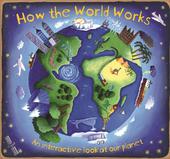
|
How the World Works
Hardback
Main Details
| Title |
How the World Works
|
| Authors and Contributors |
Illustrated by Beverley Young
|
|
By (author) Christiane Dorion
|
| Series | How The |
|---|
| Physical Properties |
| Format:Hardback | | Pages:18 | | Dimensions(mm): Height 260,Width 290 |
|
| ISBN/Barcode |
9781848771895
|
| Classifications | Dewey:508 |
|---|
| Audience | |
|---|
|
Publishing Details |
| Publisher |
Templar Publishing
|
| Imprint |
Templar Publishing
|
| Publication Date |
1 February 2010 |
| Publication Country |
United Kingdom
|
Description
How do the ocean currents move? What is a carbon footprint? Why does it rain? This fun, engaging book introduces the Earth's important cycles and offers an exciting way to learn geography and science. Packed with illustrations and novelties for interactive learning, How The World Works encourages children to think about our impact on the environment, while engendering respect for the world's natural harmonies.
Author Biography
Christiane Dorion is a writer and educational consultant who has taught sustainable development for over 20 years. She coordinated the WWF UK Primary Education programme, and has written a number of children's books about the environment. Beverley Young (Illustrator) is a freelance Artist/Illustrator living and working in Cornwall. She studied at Falmouth School of Art, where she specialised in Ceramic Design, but later returned to painting. She works in acrylic on board, and also Photoshop, creating lively, quirky illustrations for children's books, magazines, advertising and packaging.
ReviewsAlthough not as striking from a paper-engineering standpoint, the visual explanations in "How the Word Works" are nevertheless wide-ranging and impressive, covering what truly governs our days: sunlight, fresh water, winds and other key components, Writer Christiane Dorion and illutstrator Beverley Young start with the Big Bang (where else?) and end with the food chain that keeps us all going. In between are hands-on displays, such as a dial that reveals some of the thousands of objects that orbit around the earth., another dial that shows the history of the earth squeezed into 24 hours (always late to the party, humans show up 14 seconds before midnight), a flip book that follows Pangaea's dispersal into today's continents, and four pull-tabs that cleverly illustrate what happens when two continental plates come together or move apart. Double-page spreads about the weather, the movement of the sea and the carbon cycle make apparent the interconnectedness of the Earth's populations. Although the clear and informative text carries a pro-environment message, It stays clear of preachiness. The facts are what jump out at you. * The Washington Post * "careful use of paper engineering means the format is used to explain large topics. An admirable addition to bookshelves" -- Jake Hope A robust, good quality, interactive pop-up at a good price point. This excellent book explains the world in ecological and geographic terms, with all the flaps and fun you could hope for. It is suitable for quite a wide age range." * The Bookseller Children's Buyer's Guide * "How the World Works is not only ambitious but also remarkably successful...The colourful illustrations...will appeal to scientists and non-scientists alike, and have allowed for the inclusion of a wealth of information without it all being too overwhelming...all in all, this is an appealing book containing fundamental knowledge about the World to which every child should have access." * Geographical Reviews * "an intriguing scrapbook. The devices are all purposeful rather than gimmicky. This is a well-presented and enjoyable account of some complex ideas". * Child Education Plus and Nursery Education Plus * "A beautifully produced book that engages the senses in order to convey the message that our earth is a fascinating place and that it needs our protection if it is going to survive". * Carousel * "An ansolute mass of information is to be found in this book set out in an entertaining form so the pages are always fascinating and perfect for both interested dipping and more applied reading" * The School Library Association * Review by Prof Irene Tracey "This is a great idea for a book that selects just the right combination of questions ... a great book for an older sibling to read to a younger one ... definitely a book that allows a child 'repeat visits' which in my mind is a winning feature" * Eureka, The Times * "packing an astounding amount of information ... children 7-11 and their parents will find the book stimulating and hard to put down". * Science 2 * "The visual explanations in How the World Works are wide-ranging and impressive, covering what truly governs our days: sunlight, fresh water, winds and other key components. (...) Although the clear and informative text carries a pro-environmental message, it stays clear of preachiness. The facts are what jump out at you."? -- Abby McGanny * The Washington Post *
|